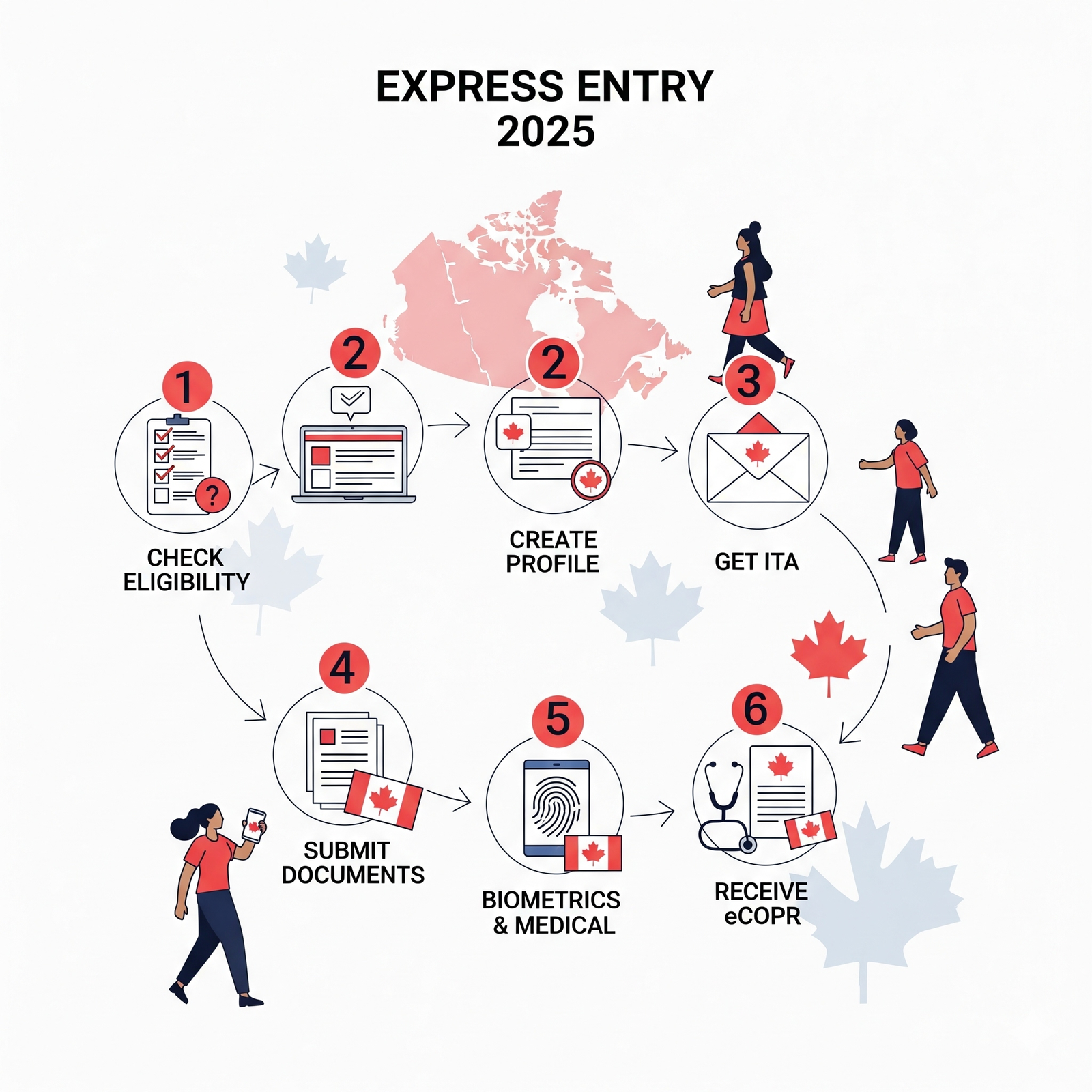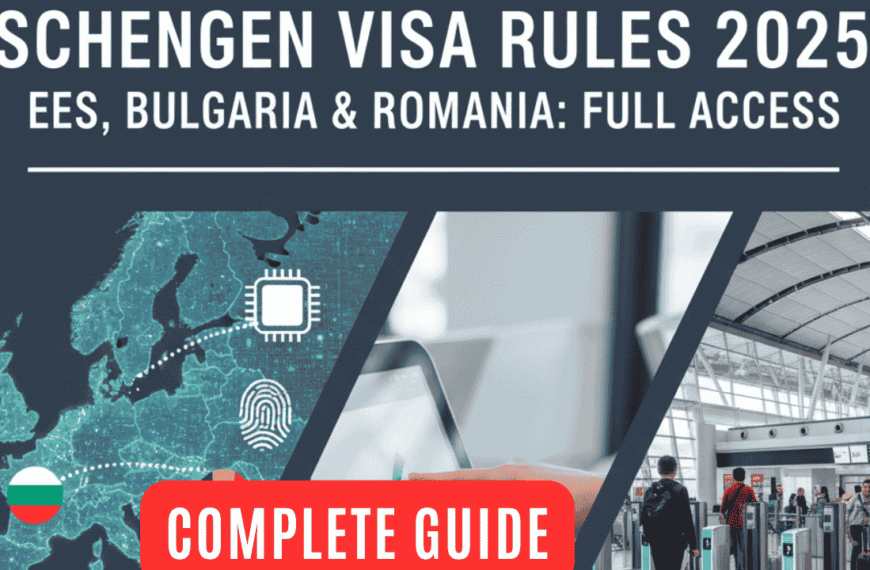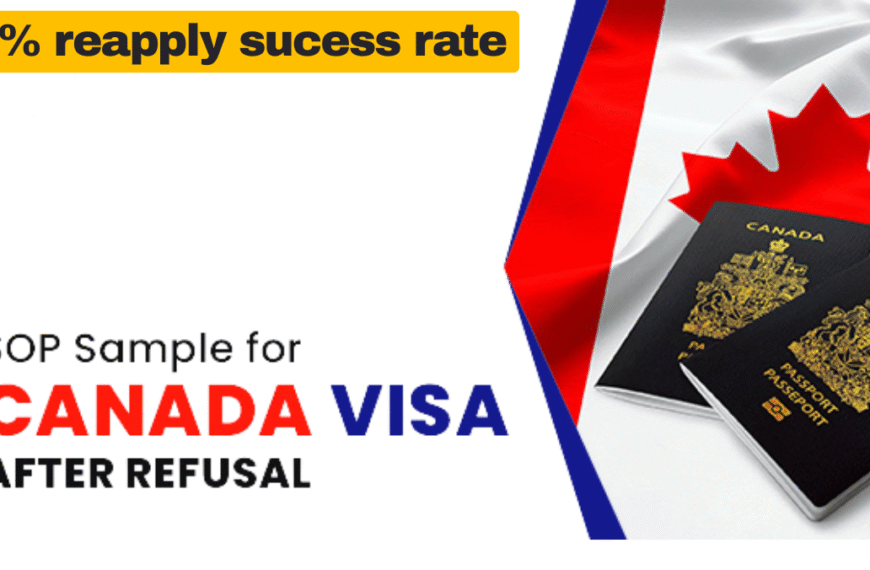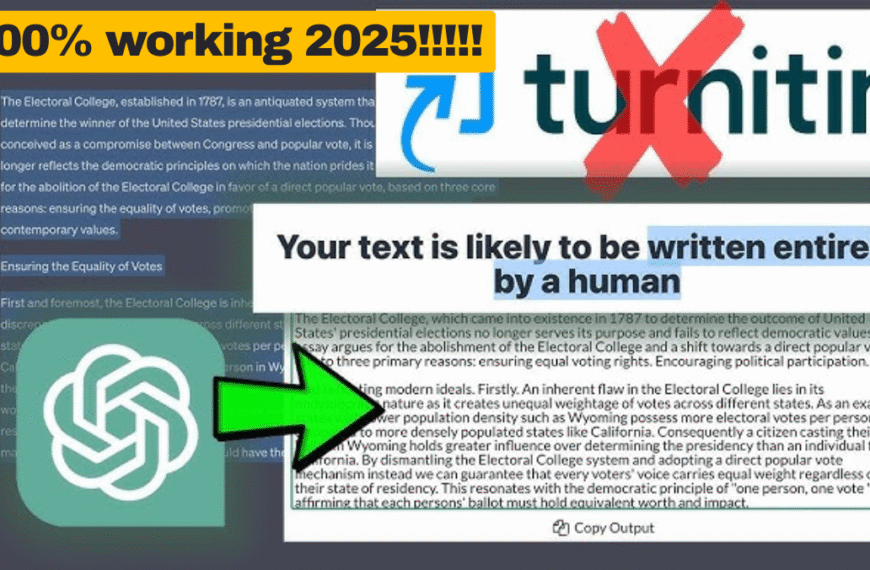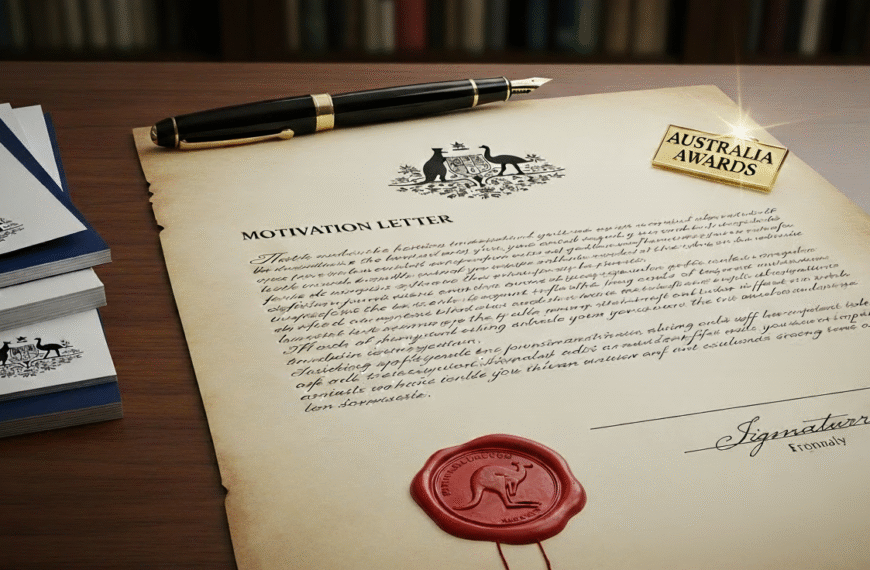- Quick overview — what Express Entry is
- Why this guide? (What you’ll get)
- Step 0 — Before you start: what you MUST know right now
- Step 1 — Check which Express Entry program fits you
- Step 2 — Language test & Education Credential Assessment (ECA)
- Step 3 — Create your Express Entry profile and calculate CRS
- Step 4 — Proof of funds & financial readiness
- tep 5 — Improve your CRS (legal, IRCC-accepted ways)
- Step 6 — Rounds of invitations & timing
- Step 7 — Get an Invitation to Apply (ITA) — now act fast
- Step 8 — Filling the PR application after ITA (what you must submit)
- Step 9 — Pay fees, submit & wait (processing times)
- Step 10 — Decision, landing, and after PR is granted
- Complete document checklist (ready to paste into WP)
- Sample timeline (realistic)
- Quick wins to increase selection chances (practical)
- Important 2025 policy notes you must watch
- FAQs: Apply for Permanent Residence through Express Entry Canada
Quick overview — what Express Entry is
Express Entry is Canada’s online system used to manage applications for three federal economic immigration programs: Federal Skilled Worker Program (FSWP), Federal Skilled Trades Program (FSTP), and Canadian Experience Class (CEC). You create a profile, get ranked by the Comprehensive Ranking System (CRS), and — if your CRS is high enough or you get a provincial nomination — you may receive an Invitation to Apply (ITA) for permanent residence.
Why this guide? (What you’ll get)
A clear, step-by-step checklist from eligibility to landing PR.
- Official requirements & document checklist.
- Practical tactics to raise your CRS (with legal, IRCC-accepted methods).
- Timeline expectations and SEO-ready structure for your blog.
Step 0 — Before you start: what you MUST know right now
- Rules change. IRCC updates policy and thresholds frequently — check official pages before applying.
- Job-offer points were removed from CRS for current and future candidates as of March 25, 2025. That change affects how you plan to increase CRS.
- Provincial nominations (PNPs) remain a fast, reliable CRS booster (nominations add 600 CRS points).
Step 1 — Check which Express Entry program fits you
Express Entry manages three programs. Quickly verify which one you match:
- Federal Skilled Worker Program (FSWP) — for people with skilled foreign work experience who meet minimum selection factors (education, language, work experience, etc.).
- Federal Skilled Trades Program (FSTP) — for qualified tradespeople.
- Canadian Experience Class (CEC) — for people with qualified Canadian work experience.
Action: Read the program requirements for each and pick the best match.
Step 2 — Language test & Education Credential Assessment (ECA)
- Language testing: Take an approved test for English (IELTS General Training or CELPIP-General) or French (TEF/TCF) and aim for the highest band you can realistically achieve. Language scores are a major CRS factor.
- ECA (if you studied outside Canada): Get an Educational Credential Assessment from a designated organization to prove your foreign degree equals Canadian standards.
Action: Book your language test ASAP and order ECA as early steps.
Step 3 — Create your Express Entry profile and calculate CRS
- Create an online Express Entry profile — you’ll enter personal, education, language and work history data. IRCC places you in the pool and gives a CRS score.
- CRS calculator & factors — core/human capital (age, education, language), spouse factors, transferable skills and additional points (e.g., provincial nomination). Note: As of March 25, 2025, job offer points were removed — plan accordingly.
Action: Use an up-to-date CRS calculator and save your profile details.
Step 4 — Proof of funds & financial readiness
- If you are applying under FSWP or FSTP, you must show proof of settlement funds unless you have a valid job offer or are currently authorized to work in Canada. IRCC lists required amounts by family size and acceptable documents.
- Note: IRCC updated some minimum amounts in 2025 — keep your profile and proof updated. Add a buffer to be safe.
Action: Prepare bank statements, fixed deposit docs, or official letters showing liquid funds per family size and dates.
tep 5 — Improve your CRS (legal, IRCC-accepted ways)
If your CRS is below recent draw cut-offs, consider these valid strategies:
- Provincial Nominee Program (PNP): Apply to relevant provincial streams; a provincial nomination gives +600 CRS points. This is often the fastest route to an ITA.
- Higher language scores: Even small increases in CLB levels can yield significant CRS gains.
- Further education or Canadian credentials: Additional degrees (or a Canadian credential) give points.
- Spouse/common-law partner factors: If your partner has high language scores or Canadian education, it helps.
- Arrange a qualifying job offer only if legitimately available (but note job-offer CRS points were removed in 2025).
Action: Make a prioritized plan: test retakes, provincial streams to target, or short-course upgrades.
Step 6 — Rounds of invitations & timing
IRCC runs rounds of invitations and invites the top-ranked candidates by CRS. Monitor the rounds of invitations to see historic cutoffs and trends — this helps you set realistic CRS targets.
Action: Track recent draws and the CRS distribution for the pool; PNP draws often have separate streams and rules.
Step 7 — Get an Invitation to Apply (ITA) — now act fast
If IRCC issues you an ITA, you will be notified in your account and you typically have 60 days to submit a complete PR application (forms, documents, fees). Start collecting all documents well before you get an ITA so you can submit within the window.
Step 8 — Filling the PR application after ITA (what you must submit)
When you get an ITA, IRCC expects a complete online application including uploaded documents:
- Completed application forms (family info, background, etc.).
- Police clearance certificates from countries where you lived for 6+ months since age 18.
- Medical exam results from IRCC-approved panel physicians.
- Proof of funds (if applicable).
- Passports and ID documents, marriage/divorce certificates (if applicable), birth certificates, photos, translations (certified).
- Any additional documents requested in your ITA letter.
Action: Have certified translations ready and police checks underway — they can take time.
Step 9 — Pay fees, submit & wait (processing times)
- Pay the required processing fees and the right-of-permanent-residence fee as instructed.
- Processing times vary; IRCC publishes rolling statistics and notes that your clock starts when they receive a complete application. Expect variability — IRCC’s historical standard for Express Entry PR is often around 6 months for completed applications, but actual times vary by volume and complexity.
Action: After submission, watch your IRCC account for messages and any additional requests.
Step 10 — Decision, landing, and after PR is granted
- If approved, IRCC will send instructions on how to become a permanent resident (landing letter or confirmation of permanent residence).
- If you are outside Canada, you may receive a COPR (confirmation of permanent residence) and a visa to travel. If you are inside Canada, you’ll follow the landing process accordingly.
Complete document checklist (ready to paste into WP)
- Passport (bio page) — clear scan.
- Birth certificate.
- Marriage certificate (if applicable).
- Police certificates (all countries where you lived 6+ months).
- IRCC medical exam report (from approved physician).
- Language test results (IELTS/CELPIP/TEF etc.).
- Educational Credential Assessment (ECA) report (if required).
- Proof of funds (bank statements, savings, fixed deposit certificates).
- Work references/letters with contact info, dates, duties.
- Job offer / employer documents (if applicable — but note CRS job-offer points removed).
- Certified translations and photocopies.
Sample timeline (realistic)
- 6–12 months before applying: Take language tests, order ECA, improve skills.
- 3–6 months before: Build resume, compile documents, check PNP streams.
- Profile creation: Create Express Entry profile (no fee).
- After ITA: 60 days to submit PR application with supporting documents.
- Processing: Check IRCC processing times regularly.
Quick wins to increase selection chances (practical)
- Apply to targeted PNP streams that match your job/skill set. PNP = +600 CRS.
- Aim for high language scores — often the easiest and highest-impact change.
- Consider short, recognized certificate courses that increase your points or employability.
- Keep your Express Entry profile current — update new job experience, language retests, or ECA upgrades.
Important 2025 policy notes you must watch
- Removal of job-offer CRS points (Mar 25, 2025). This changed the value of job offers in CRS calculations — plan with that in mind.
- Proof of funds adjustments: IRCC made small upward adjustments to minimum required funds in 2025 — keep your proof current and allow a buffer.
Conclusion
Landing Canadian permanent residence through Express Entry in 2025 and beyond is entirely achievable for international applicants who take the time to thoroughly understand the different federal programs, strategically maximize their Comprehensive Ranking System (CRS) score, and ensure all required documents are accurate and ready well in advance. By carefully preparing each step of your profile, paying close attention to language proficiency, education, and work experience, and submitting a complete application promptly after receiving an Invitation to Apply (ITA), you can significantly increase your chances of success. Following a clear, step-by-step approach, staying updated with policy changes, and leveraging all available resources ensures that your Express Entry journey is not only smooth but also highly effective in securing Canadian permanent residence.
FAQs: Apply for Permanent Residence through Express Entry Canada
Express Entry is Canada’s online system for managing applications for permanent residence under economic immigration programs, including the Federal Skilled Worker Program, Federal Skilled Trades Program, and Canadian Experience Class.
Eligibility depends on factors like age, education, work experience, language proficiency (English or French), and adaptability. Each program under Express Entry has specific requirements.
You need to create a profile on the Immigration, Refugees and Citizenship Canada (IRCC) website. You must provide details about your skills, work experience, language test results, and education credentials.
The CRS score is a points-based system used to rank candidates in the Express Entry pool. It considers factors like age, education, work experience, language skills, and additional factors like a provincial nomination or a Canadian job offer.
You can improve your score by improving language test results, gaining additional work experience, completing higher education, securing a job offer from a Canadian employer, or obtaining a provincial nomination.
The time varies depending on your CRS score and the draws conducted by IRCC. Generally, candidates with higher CRS scores receive invitations faster, sometimes within a few weeks.
Common documents include passport, language test results, educational credential assessments, work experience letters, proof of funds, police clearance certificates, and medical examination reports.
Yes, you can include your spouse or common-law partner and dependent children in your application. Their information and supporting documents must be provided.
Application fees vary depending on the program. Generally, the processing fee for the principal applicant is CAD 1,365, which includes the right of permanent residence. Additional fees apply for dependents.
Once submitted, IRCC will review your application, conduct background and security checks, and may request additional documents. After approval, you’ll receive your Confirmation of Permanent Residence (COPR) and can make your move to Canada.
